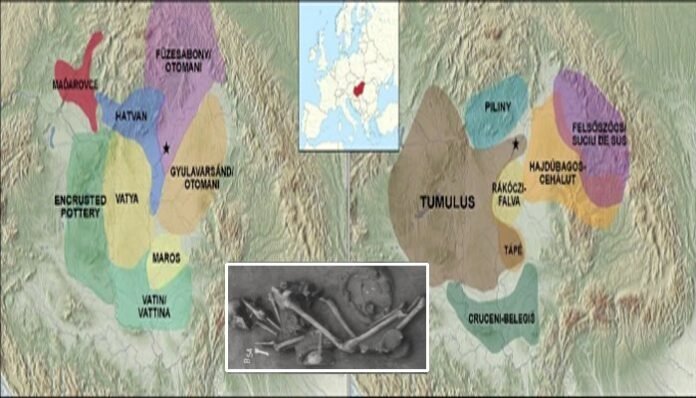Conny Waters – AncientPages.com – Researchers conducted an examination of the Bronze Age cemetery of Tiszafüred-Majoroshalom that shed new light on a crucial period in Central European history.
An international research team led by Tamás Hajdu, associate professor at the Department of Anthropology at Hungary’s Eötvös Loránd University and Claudio Cavazzuti, senior assistant professor at the University of Bologna, studied the site.
Tiszafred Majoroshalom B54. Image credit: Kovcs 1995, Abb. 1/A, 2-3 s Dani Jnos et al. 2025
A 3, 500-year-old cemetery near Tiszafüred offers insights into life changes at the start of the Late Bronze Age, which was an important period in Europe.
This important study revealed that around 1500 BC, significant transformations took place in people’s lives, as their dietary habits and living conditions underwent substantial changes.
Additionally, the social structure experienced a comprehensive reorganization.
The Bronze Age cemetery at Tiszafüred-Majoroshalom, used during the Middle (Füzesabony culture) and Late Bronze Age (Tumulus culture), enabled researchers to compare subsistence strategies across eras.
The researchers embarked on an important quest to determine whether the expansion of the Tumulus culture signified the arrival of new groups or if it was simply a transformation in material culture. At the same time, the indigenous people maintained their way of life.
Geographic distribution of MBA (left) and LBA (right) cultures in the Carpathian Basin. The star symbol indicates the position of Tiszafüred-Majoroshalom cemetery. Image source
This investigation is crucial for understanding historical dynamics and cultural evolution, offering insights that could reshape our perception of past societies.
Moreover, they also examined the intriguing question of whether the archaeologically observed settlement changes around 1500 BC indicate a shift in lifestyle: whether people began to follow a lifestyle involving mainly animal husbandry and frequent migration, rather than settled farming.
Among the most important results of this research are the people’s dietary habits. For example, during the Middle Bronze Age, preceding this transition, the inhabitants maintained a more diverse diet, with certain members of the community having access to animal proteins.
In the Late Bronze Age, diets became more uniform yet poorer, likely due to the introduction of millet, a fast-growing, high-energy plant. Evidence at Tiszafüred-Majoroshalom shows the earliest known consumption of millet in Europe, and millet is a high-energy plant that grows quickly.
Earlier, during the Middle Bronze Age, people’s food consumption was much more diverse especially in access to animal proteins.
The study’s findings reveal that, following the year 1500 B.C., society within the region experienced a marked shift towards reduced mobility. This period was characterized by a notable decline in the influx of immigrants, suggesting a more insular and perhaps stable social structure.
However, it is important to note that those few individuals who did make their way to this area during this time undertook journeys from other geographical regions like the Southern Carpathians or Transdanubia.
Based on radiocarbon dating, immigration began as early as the 1500s BC, which supports that the communities living further west had indeed reached the Great Hungarian Plain at the time of the appearance of the Tumulus culture.
At the onset of the Late Bronze Age, there was a notable shift as the traditionally utilized tell settlements were vacated, leading to habitation within less centralized settlement networks. This transition resulted in a more relaxed and less structured social system, which is also mirrored in the dietary practices of that period.
Subsequent analyses revealed a notable reduction in the consumption of animal protein during this period compared to earlier times. This finding challenges the previously held notion that individuals associated with the Tumulus culture primarily engaged in animal husbandry.
The study, published in the journal Scientific Reports, refutes that the previous idea that Tumulus culture people were mostly pastoralists, and instead, shows that the changes associated with the emergence of the Tumulus culture (around 1500 BC) – such as the observed differences in people’s lifestyles, burial customs and settlements – can only be truly understood if traditional archaeological and anthropological studies are combined with modern bioarchaeological analyses.
Written by Conny Waters – AncientPages.com Staff Writer








